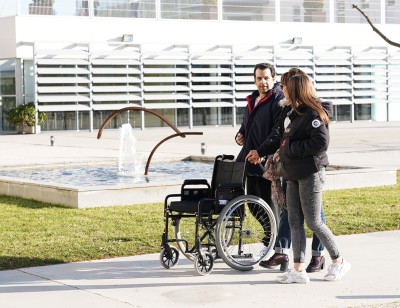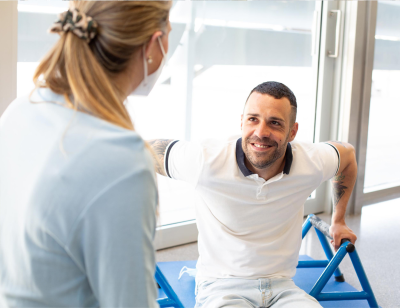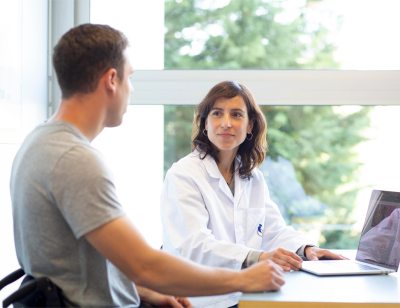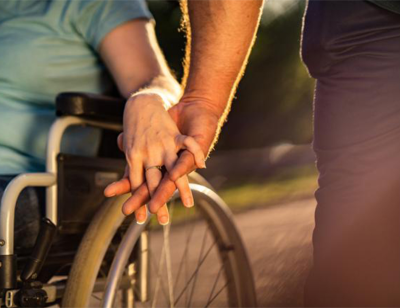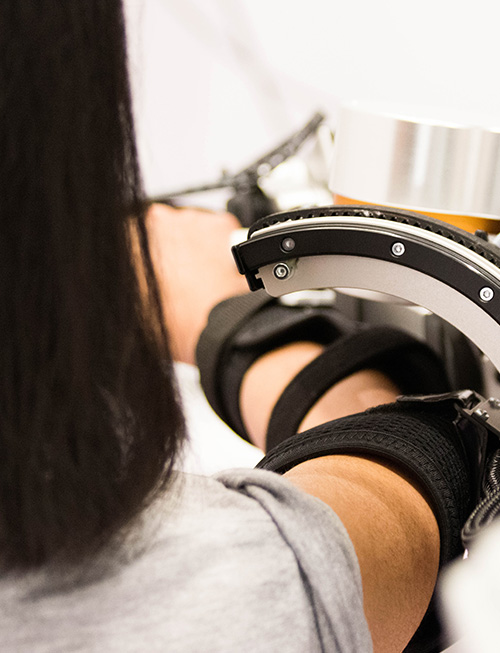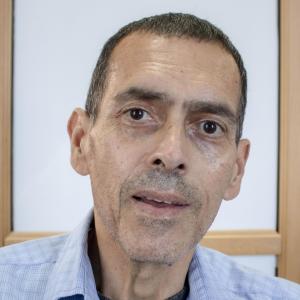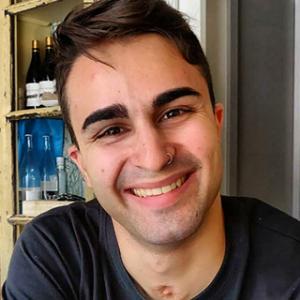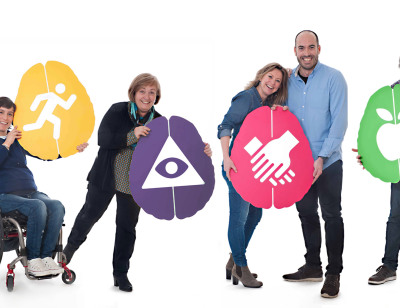Meet the Neurorehabilitation Team
Stroke
After a stroke:
sequelae
The consequences of a stroke depend on the location of the injury and its extent.
A stroke in the right hemisphere often causes paralysis in the left side of the body (left hemiplegia). In addition, the following may appear:
- Problems with spatial perception.
- Left neglect: objects and people on the left side of the patient are ignored.
- Ignorance or non-recognition of sequelae.
A stroke in the left hemisphere generally causes paralysis of the right side of the body (right hemiplegia) and various language disorders that we know generically by the term aphasia.
When the stroke happens in the cerebellum, this will cause problems with lack of coordination, imbalance, dizziness, nausea and vomiting.
Strokes located in the brain stem can be more serious. The control of all involuntary functions such as breathing, heartbeat, blood pressure, etc. is found in this area. In addition, it also controls functions such as swallowing, speech, hearing and eye movements. In addition, the pathways that carry information from the cerebral hemispheres pass through the brain stem to the extremities, so an injury to them also lead to paralysis of one or two hemibodies.
Scientific studies show that in any of these cases the earlier a suitable neurorehabilitation treatment is started by an expert multidisciplinary team, the better the long-term functional results.
Stroke prevention
The main risk factors for stroke are now well identified:
Non-modifiable risk factors
- The risk of stroke increases with age.
- The risk of stroke is higher in men.
- Afro-Americans have a higher risk percentage than other races.
- Family history of stroke.
Fortunately, however, there are many other modifiable factors, including the following:
Modifiable risk factors
- Hypertension.
- Heart disease (angina pectoris, ischaemic heart disease and arrhythmia).
- Tobacco consumption.
- High level of fat in the blood.
- Diabetes mellitus.
- Obesity.
- Sedentary lifestyle.
Every second counts
The sooner the patient reaches hospital and starts rehabilitation treatment, the fewer the consequences of a stroke. Therefore it is vital to identify the warning signs early to activate the Stroke Code.
The warning signs are:
- Sudden onset of loss of strength in the face, arm and/or leg on one side of the body.
- Sudden onset of sensation disorders, feeling of “numbness or tingling” in the face, arm and/or leg on one side of the body.
- Sudden partial or total loss of vision in one or both eyes.
- Sudden speech disturbance, difficulty expressing oneself, difficulty articulating and being understood by the listener.
- Sudden-onset headache of unusual intensity and without apparent cause.
- Feeling of severe vertigo, instability, imbalance or sudden unexplained falls, if accompanied by any of the symptoms described above.
Stroke rehabilitation at the Institut Guttmann
At the Institut Guttmann we carry out a highly specialised neurorehabilitation process aimed at restoring, minimising and/or compensating functional alterations caused by a stroke. We provide patients with comprehensive, continuous, personalised care based on the intervention of an expert multidisciplinary team.
The lives of people affected by a stroke can be considerably improved by scientific rigor and human warmth, taking advantage of the possibilities offered by the most modern technologies and applying specific clinical procedures that can provide significant qualitative improvements. The main goals during the rehabilitation process are achieving the highest possible level of autonomy, recovery of self-esteem, and satisfactory active and mainstream social inclusion.
In the initial phase of the injury, the Institut Guttmann will make all the centre’s healthcare facilities available to the patient to provide the most flexible and efficient response to medical and surgical treatment and comprehensive rehabilitation.
Outcomes of the rehabilitation process
Active Life
A programme for empowerment, community training and starting independent living.
The Active Life programme is an innovative programme that goes one step beyond the traditional vision of hospital rehabilitation. The aim is to ensure that people regain the maximise amount of functional autonomy, as well as their ability to make decisions and manage their own lives according to their own lifestyle in an active and participatory way.
The origin of this initiative stems from the need to transfer learning and skills acquired during the rehabilitation process to the community environment. This facilitates adaptation and helps normalise the person’s new situation within the community.
This programme is adapted to the specific needs of each person and can be carried out whenever they need to acquire skills to learn to live independently.

Preparing to return home
An intensive empowerment and rehabilitation programme in an adapted environment designed for you
This programme is specifically aimed at people affected by the aftermath of a stroke or brain injury. The onset of a disability means adapting to a new way of living and returning home can fill the patient with fears and anxiety. In these cases, we offer the possibility of following intensive outpatient rehabilitation treatment and complementing this with a stay in an adapted apartment with a family member or main caregiver. The aim of the programme is to empower the caregiver and the individual to manage daily activities, dressings and even rehabilitation, playing an active role in the process of regaining independence and returning home. The programme combines a stay in an apartment with rehabilitation treatment and includes the intervention of a professional member of staff in cases where specific help or training is required.
A space that is adapted and designed for you
GBL apartments
Guttmann Barcelona Life is a social facility consisting of a group of fully adapted and automated apartments that offer a wide range of complementary services tailored to each user.
The apartments share a building with the Guttmann Barcelona Brain Health and Neurorehabilitation Institute, so it is possible to combine a stay with a specialised neurorehabilitation treatment.
References on stroke
Rehabilitación del ictus: modelo asistencial. Recomendaciones de la Sociedad Española de Rehabilitación y Medicina Física, 2009. E. Duartea,, B. Alonsoa, M.J. Fernández, J.M. Fernández, M. Flóreza, I. García-Montes,
J. Gentil, L. Hernández, F.J. Juan, B. Palomino, J. Vidal, E. Viosca, J.J. Aguilar, M. Bernabeu, I. Bori, F. Carrión, A. Déniz, I. Díaz, E. Fernández, P. Forastero, V. Iñigo, J. Junyent, N. Lizarraga, L. López de Munaín, I. Máñez, X. Miguéns,
I. Sánchez y A. Soler.

